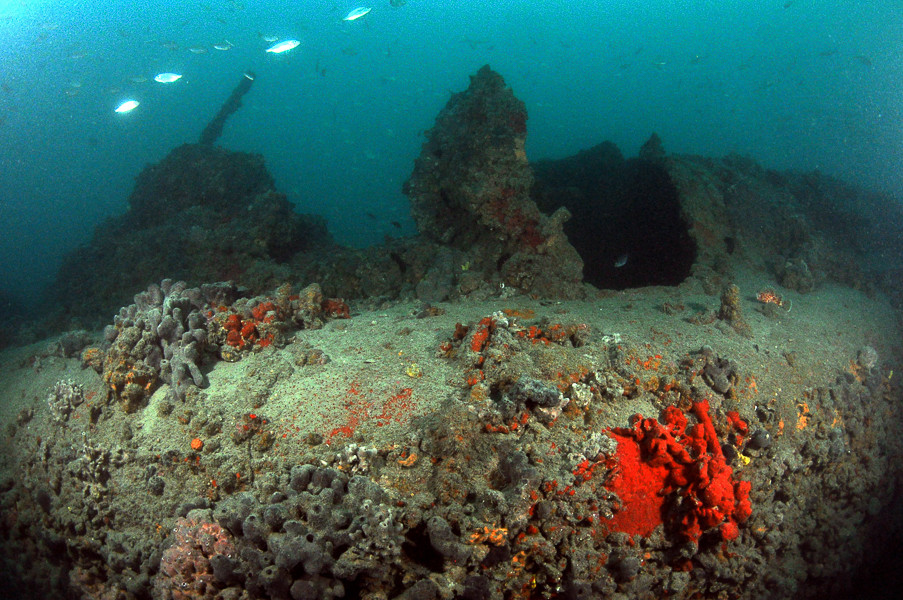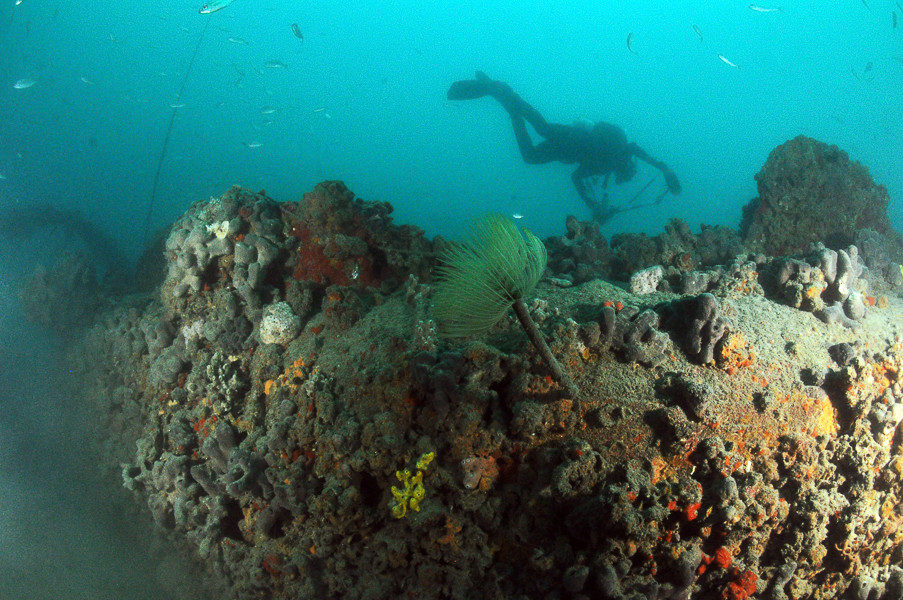
TB 26 FLAMINGO
DEPTH: 41 - 46 m
SKILL: Advanced
TB 26 Flamingo; Schichau type torpedo boat, built under license in Trieste and Pula; Austro-Hungarian
Built: STT (Stabilimento Tecnico Triestino) Launched on 28th August 1889, entered into service on 17th March 1890
Sunk: 23rd August 1914 (underwater mine)
Dimensions: l=39 m, w=4.5 m, draught=1.1 m
Coordinates: 44.72078° N, 13.81164° E
Location: W from the patrol line Porer-Peneda
Access: 2/5 access is solely by boat (the location is in the open sea)
Visibility: 2/5 in summer low, in winter considerably better
Current : 3/5 mostly variable, occasionally strong
Flora and fauna: 3/5 varied life on and around the wreck, occasionally specimens of large fish
HISTORY:
The Austro-Hungarian steam torpedo boat Flamingo belonged to the German type Schichau, which was built under license in Trieste and Pula at the end of the 19th century. The first two boats and another six more later were built in Elbing, Germany, whilst the rest were built in Croatia. The Flamingo belonged to the series which had one torpedo tube beneath the bow. The keel was laid down at STT in December of 1888, it was launched on 28th August 1889, and it went into service on 17th March 1890. The designations of this class of torpedo boat were changed from names to numbers, so that the boat which was previously Flamingo became Torpedoboot 26 or simply TB 26. After 1910, this type of boat became outdated, so from 1912 the majority served for secondary tasks such as minesweepers, harbour patrol ships and so on.
The TB 26 was used at the beginning of the war for patrol duty around the naval harbour of Pula. According to the “Ordre-de-Bataille” (battle orders) on 27th June 1914, TB 26 belonged to the 15th torpedo boat fleet (15 Torpedobootsgruppe) within the Trieste command region (Seebezirkskommando Triest) and IV mine defence command (Seeminenkommando IV), along with torpedo boat “20”.
On the night of 22nd-23rd August 1914, TB 26 was sailing its patrol route between the Porer lighthouse and the Cape of Pened on the Brijuni Isles, when at around 0230 hrs. a strong explosion shook it on the right side of the stern. The torpedo boat had undoubtedly struck a mine which had exploded. Initially water did not deeply penetrate the boat, and the ship kept itself on the surface until 0330 hrs., when the commander ordered the lifeboats and rafts into the sea, and signals from the fortress Verudela announced that two other torpedo boats were arriving to assist. The crew had begun to abandon ship at 0330 hrs., but the lifeboat (a yawl) was almost full of water and the people, because of the “bura” wind, were not able to keep themselves afloat. Torpedo boats “20” and “30” arrived on the scene at about 0845 hrs., which was tragically too late for part of the crew of the Flamingo. The torpedo boats saved only the commander and six men, whilst the cadets and ten of the other crew members drowned.
WRECK CONDITION AND DIVING:
The TB 26 Flamingo is one of the rare known wrecks of ships from the 19th century. The wreck lies at a depth of 49 metres and since it is in the open sea, it cannot be located without the use of GPS devices and a good graphic echo sounder as the hull of the wreck is only 2-3 metres above the seabed. The wreck lies on the bottom in an upright position, and when at a dive depth of 25-30 m, if visibility is average, we can make out the slender line of the bow which is outlined on the light sand of the seabed. The upper parts of the torpedo boat are heavily overgrown by sponges and crustaceans, which is no surprise knowing that the wreck has been at the bottom of the sea for so many years.
Coming up to the command turret, we can see that it is missing its upper part so it is easy to see the complex mechanism on its upper part. This is the remainder of the steering gear for controlling the boat. Through the turret we can carefully enter the bow section of the wreck, in which the visibility is much better than the outside of the wreck. Crossing very carefully over the horizontal bulkhead we can enter the bow of the wreck itself at the bottom of which lies the torpedo tube. The tube is open and empty, the rear hatch is missing. Unfortunately, some time ago one foreign diver removed it, a known robber of Croatia’s undersea heritage. In the bow also lies the head of one torpedo. There isn't a torpedo itself in the bow, but it is not recommended to touch the head since it isn’t known whether this is a live or training warhead. The plating of the head is a green colour and isn’t overgrown, which means that it was probably made from copper plate.
Coming out of the interior and swimming towards the stern, we come across the place where the funnel was. On the bottom around the boat are the remains of the stern structure and plating which has fallen from the wreck. On all sides are the indications of advanced corrosion, which reminds us that the lifetimes of all the metal wrecks in the Adriatic are limited and that with time they will all be irretrievably lost. TB 26 Flamingo is one of the oldest metal wrecks and therefore of special value, all the more so as it is the only torpedo boat of this type in the Adriatic which is accessible for diving.
The description and illustrations are a courtesy of Danijel Frka and Jasen Mesić. Buy the whole book here: https://shop.naklada-val.hr/product_info.php?products_id=561
Built: STT (Stabilimento Tecnico Triestino) Launched on 28th August 1889, entered into service on 17th March 1890
Sunk: 23rd August 1914 (underwater mine)
Dimensions: l=39 m, w=4.5 m, draught=1.1 m
Coordinates: 44.72078° N, 13.81164° E
Location: W from the patrol line Porer-Peneda
Access: 2/5 access is solely by boat (the location is in the open sea)
Visibility: 2/5 in summer low, in winter considerably better
Current : 3/5 mostly variable, occasionally strong
Flora and fauna: 3/5 varied life on and around the wreck, occasionally specimens of large fish
HISTORY:
The Austro-Hungarian steam torpedo boat Flamingo belonged to the German type Schichau, which was built under license in Trieste and Pula at the end of the 19th century. The first two boats and another six more later were built in Elbing, Germany, whilst the rest were built in Croatia. The Flamingo belonged to the series which had one torpedo tube beneath the bow. The keel was laid down at STT in December of 1888, it was launched on 28th August 1889, and it went into service on 17th March 1890. The designations of this class of torpedo boat were changed from names to numbers, so that the boat which was previously Flamingo became Torpedoboot 26 or simply TB 26. After 1910, this type of boat became outdated, so from 1912 the majority served for secondary tasks such as minesweepers, harbour patrol ships and so on.
The TB 26 was used at the beginning of the war for patrol duty around the naval harbour of Pula. According to the “Ordre-de-Bataille” (battle orders) on 27th June 1914, TB 26 belonged to the 15th torpedo boat fleet (15 Torpedobootsgruppe) within the Trieste command region (Seebezirkskommando Triest) and IV mine defence command (Seeminenkommando IV), along with torpedo boat “20”.
On the night of 22nd-23rd August 1914, TB 26 was sailing its patrol route between the Porer lighthouse and the Cape of Pened on the Brijuni Isles, when at around 0230 hrs. a strong explosion shook it on the right side of the stern. The torpedo boat had undoubtedly struck a mine which had exploded. Initially water did not deeply penetrate the boat, and the ship kept itself on the surface until 0330 hrs., when the commander ordered the lifeboats and rafts into the sea, and signals from the fortress Verudela announced that two other torpedo boats were arriving to assist. The crew had begun to abandon ship at 0330 hrs., but the lifeboat (a yawl) was almost full of water and the people, because of the “bura” wind, were not able to keep themselves afloat. Torpedo boats “20” and “30” arrived on the scene at about 0845 hrs., which was tragically too late for part of the crew of the Flamingo. The torpedo boats saved only the commander and six men, whilst the cadets and ten of the other crew members drowned.
WRECK CONDITION AND DIVING:
The TB 26 Flamingo is one of the rare known wrecks of ships from the 19th century. The wreck lies at a depth of 49 metres and since it is in the open sea, it cannot be located without the use of GPS devices and a good graphic echo sounder as the hull of the wreck is only 2-3 metres above the seabed. The wreck lies on the bottom in an upright position, and when at a dive depth of 25-30 m, if visibility is average, we can make out the slender line of the bow which is outlined on the light sand of the seabed. The upper parts of the torpedo boat are heavily overgrown by sponges and crustaceans, which is no surprise knowing that the wreck has been at the bottom of the sea for so many years.
Coming up to the command turret, we can see that it is missing its upper part so it is easy to see the complex mechanism on its upper part. This is the remainder of the steering gear for controlling the boat. Through the turret we can carefully enter the bow section of the wreck, in which the visibility is much better than the outside of the wreck. Crossing very carefully over the horizontal bulkhead we can enter the bow of the wreck itself at the bottom of which lies the torpedo tube. The tube is open and empty, the rear hatch is missing. Unfortunately, some time ago one foreign diver removed it, a known robber of Croatia’s undersea heritage. In the bow also lies the head of one torpedo. There isn't a torpedo itself in the bow, but it is not recommended to touch the head since it isn’t known whether this is a live or training warhead. The plating of the head is a green colour and isn’t overgrown, which means that it was probably made from copper plate.
Coming out of the interior and swimming towards the stern, we come across the place where the funnel was. On the bottom around the boat are the remains of the stern structure and plating which has fallen from the wreck. On all sides are the indications of advanced corrosion, which reminds us that the lifetimes of all the metal wrecks in the Adriatic are limited and that with time they will all be irretrievably lost. TB 26 Flamingo is one of the oldest metal wrecks and therefore of special value, all the more so as it is the only torpedo boat of this type in the Adriatic which is accessible for diving.
The description and illustrations are a courtesy of Danijel Frka and Jasen Mesić. Buy the whole book here: https://shop.naklada-val.hr/product_info.php?products_id=561








 The investment is co-financed by the Republic of Slovenia and the European Union from the European Regional Development Fund.
The investment is co-financed by the Republic of Slovenia and the European Union from the European Regional Development Fund.  H2O Globe BETA
H2O Globe BETA